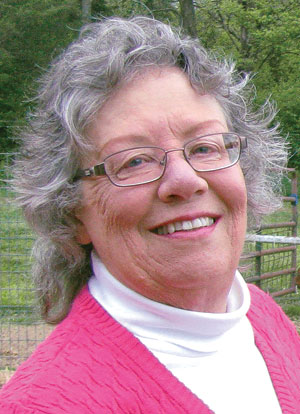
On the picturesque 10-acre Holaday Farm near Springfield, Mo., in Greene County, Barbara Holaday raises Boer goats.
Her husband, Steve, helps when needed, but Barbara does most of the work with the goats herself. “It’s my ‘thing,’” she said.
Her first goats came from a swap meet in 1993 or 1994 when she bought two Nubian.
“I’ve just always thought goats were neat and cute,” Barbara said. “Whenever I would see some out in the field I’d say, ‘Oh, look at the little baby goats.’ I didn’t do it from an economic standpoint.”
Around 1995, Barbara got into Boer goats.
“I bred my Nubians to some Boer bucks,” she recalled. “It kind of took off from there, and I had a good market for them.”
Barbara said the Boer breed was “just catching on in the 1990s and coming to the United States.” Even though she had a couple of Nubians, which are a dairy breed, Barbara never went into milk production.
“I didn’t milk because I didn’t want to get married to the milk stand twice a day, and I had a full-time job,” she recalled. “I thought the Boer goats would be a good goat to migrate to because they don’t usually milk the meat goats. They were commanding a very good price for the percentages and the full-bloods.” Even though she does like the Nubian breed, Barbara no longer has any in her operation.
The best farming advice Barabra said she ever received was to start small.
“Start with a few; no more than five goats before you ever expand,” she said. “Learn about their metabolism and health. Learn how to choose good ones, parasite-resistant ones. Learn good management.”
Barbara insists good management is key to a successful goat herd.
“I’ve been to a lot of seminars and visited a lot of farms,” she said. “Get out there and see what other people are doing and decide what you want to incorporate on your farm.
“A lot of people get out of goats because they have problems with managing goats. If you learn first, you won’t have as many problems and you won’t get caught losing a lot of money because you’ve got a whole bunch of goats and don’t manage them well.”
Barbara likes the Boer goats because she believes they are easier to manage.
She puts them in stalls and deworms them, and has their feet trimmed as often as possible. Barbara also uses a lot of herbs and essential oils to boost their immune system, and kill or deter parasites.
“It’s helped my goats a lot. When you’re deworming with essential oils, I mix the essential oil and a carrier oil, put it on a cookie, and feed it to the goats. They love that. They love gingersnaps, but they aren’t too picky,” she said.
Barbara has several dapple Boer goats.
“From the South Africans, we started with the traditional-colored Boer goat,” she explained. “That’s the white ones with the red heads. Then paint got kind of popular and then red. People started getting more and more of those. Then when the dapples started getting more popular, that sort of took off. I like them too.”
While she likes the coloring of her dappled goats, she still wants a structurally correct animal.
“It’s been kind of a challenge to make sure you get a good quality dapple with good conformation,” Barbara said.
Although popular now, Barbara said the dapples started out as “accidents.”
“The South Africans used many indigenous goat breeds to develop the Boer goat and some of those breeds were naturally spotted, so all those different goats are in the background somewhere,” she explained.
“While the South Africans tried to solidify the breed so they would get mostly all white with red heads, once in a while something else would pop up. Americans would save and start producing those.”
She believes the appeal of the dapple is the color and that it’s something different.
“Seems like the black Dapples are most popular at the moment,” she said.
Barbara sells mostly breeding stock, but she is careful about the animals she sells to other producers.
“I have a lot of bucks,” she said. “Some that are not as good a quality, and I don’t want to sit on a bunch of bucks trying to sell them to individuals, I’ll take them to the sale barn.”
Barbara has her grain custom mixed for her operation.
“It’s mostly oats, barley, wheat bran, and an extender pellet of some sort,” she said. “I have a nutritionist balance it, and he will help me figure out what works. Right now I’ve added some sunflower seeds and alfalfa pellets, and took out soy hull pellets.”







